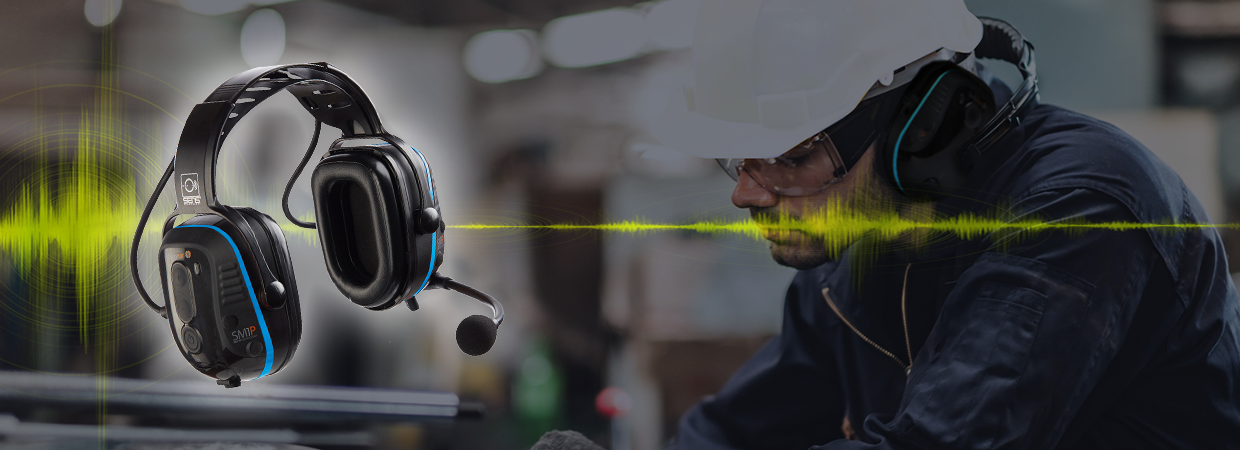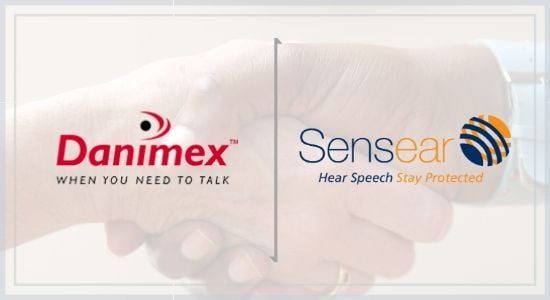- Home
- Blog
- Hearing Protection
- How to Choose the Right Hearing Protection

Hearing protection is more important than ever as hearing loss is now the third leading chronic physical health condition among adults in the United States. One in every eight workers has a challenge hearing, and occupational exposure is responsible for one in four of those issues, according to the Centers for Disease Control and Prevention (CDC).
Recognized each October, National Protect Your Hearing Month is the perfect time to identify the best ear protection and strategies for maintaining communication and safety in busy work environments. Noise-cancelling hearing protection can increase productivity while reducing accidents and incidents.
This guide is designed to help you choose the right hearing protection for your team and your business.
Understanding Noise Reduction and Hearing Protection Basics
There are different types of hearing protection and different types of ear protection, so it is important to understand what factors may impact the effectiveness of earmuffs, for example, and what works best in the noisiest environments.
It all starts with noise reduction ratings.
Explaining Noise Reduction Ratings (NRR)
These ratings are a standardized measurement that quantifies the effectiveness of hearing protection devices, such as earplugs and headsets, by indicating the level of noise reduction provided in decibels (dB). The higher the NRR value, the greater the noise reduction, as long as the device is worn properly.
The National Institute for Occupational Safety and Health (NIOSH), which is part of the CDC, recommends exposure limits of 85 A-weighted decibels (dBA). Understanding these ratings is critical for occupational health and safety.
Types of Hearing Protection at a Glance
There are three main options for ear protection in the workplace:
-
Earplugs: Earplugs are designed to slide securely into the ear and may be pre-formed, expandable, or custom-made.
-
Earmuffs: This option surrounds the entire ear and is secured with a headband or attached to a hard hat.
-
Earbands: In-ear monitors can be placed inside the ear canal and are held in place by a band.
The Importance of Proper Fit for Effective Noise Reduction
Sound-canceling ear protection relies on proper fit. Any option you choose for your business must fit workers snugly to prevent hearing damage. In addition, sound-cancelling ear protection can be customized for individual workers and businesses.
Understanding the Different Types of Ear Protection
Selecting hearing protection is a critical step for ensuring worker safety and success. This hearing protection selection guide will help you better understand ear protection options and confidently choose the best type of hearing protection for your team.
Earplugs
Earplugs come in multiple materials and options:
-
Foam earplugs: Made of soft, moldable foam, foam earplugs expand to fill the ear canal when inserted. They are designed for one-time use only, and the average worker uses about two pairs per day, so they can be an expensive option and are less effective at noise reduction than other earplugs.
-
Silicone earplugs: Pre-molded earplugs are often made from silicone, which molds to the ear when inserted. They can generally be washed and reused, offering a longer lifespan than foam earplugs.
-
Custom-molded earplugs: Custom-molded earplugs are tailored to the unique shape of each user's ear and offer better hearing protection than foam and silicone earplugs.
Earmuffs and Headsets
When it comes to noise-cancelling earmuffs and headsets, there are two chief options to consider:
-
Passive noise-cancelling earmuffs: Used to physically block sound waves from reaching the ear canal, passive noise-cancelling earmuffs provide good noise reduction in loud environments, but they can also block all sounds and prevent workplace communication.
-
Electronic noise-cancelling earmuffs: A more sophisticated option, electronic noise-cancelling earmuffs can reduce environmental noise while allowing speech and other important communications to come through.
Earbands
Earbands are wearable devices that can reduce the intensity of sound and protect against hearing loss. They may also include pads or tips that seal near the ear canal. Earbands are usually made of foam-like material that molds to the ear’s shape and can also hold earplugs in place.
In-ear Monitors
In-ear monitors (IEMs) are discreet earphones placed inside the ear canal and are particularly popular among musicians who want to hear themselves during a live performance. IEMs have a small form factor and are good for workers on the move.
Advanced Hearing Protection Technologies
Workplaces that take employee safety seriously choose to go beyond basic hearing protection to more robust hearing protection techniques and technologies. Sensear's high-noise environment headsets are at the forefront of digital workplace safety technology. The latest technology features active noise control and SENS® (Speech Enhancement and Noise Suppression) Technology.
Active Noise Control (ANC)
ANC offers superior protection against a wide range of frequencies, canceling out harmful noise and background noise while allowing important communications to be heard clearly. By canceling the lower-frequency sounds of background noise, ANC technology eliminates unwanted noises in the environment. Sensear’s active noise cancelation headsets pick up ambient sounds from the headset’s outer shell and create an analog waveform opposite to the noise. This enhances both hearing protection and situational awareness.
SENS® Technology
The advanced SENS® Technology by Sensear features speech enhancement with noise suppression to deliver 360° situational awareness. SENS® Technology elevates noise cancellation by isolating and enhancing speech while reducing harmful background noise. With Sensear headsets, users can maintain 360° situational awareness of their environments through active noise control—a critical component of workplace safety. This means workers can communicate face-to-face, at short and long distances via two-way radio and Bluetooth® cell phone while keeping headsets on.
SENS® Technology adapts quickly to changes in background noises, keeping workers protected from excessive noise produced by machinery, heavy vehicles, explosions, and more. All Sensear devices have passed the required hearing protection certification standards within the communication industry to ensure effective hearing protection for users. Sensear’s headsets also work with hearing aids for workers suffering from previous hearing loss.
Selecting the Right Hearing Protection: A Step-by-Step Guide
This hearing protection selection guide will help you pinpoint the best solutions for your workers and industry. Sensear can also work with your company to successfully determine the best ear protectors and hearing protectors for your team.
Know Your Noise Reduction Needs
Do you know what your noise reduction needs are? Naturally, they vary from industry to industry and even from job site to job site.
In just two simple steps, you can better determine your noise reduction needs and the best types of hearing protection to meet those needs.
-
Measure noise levels: The NIOSH Sound Level Meter App can measure and characterize occupational noise exposure to determine if workplace noise is hazardous or not.
-
Determine required noise reduction: After you have determined just how loud your workplace is, you should aim to reduce exposure to 75-85 dBA. For every 10dB of hearing loss, the risk of falling increases by 140%, just one of the reasons that noise reduction is so important to a safe and productive workplace.
Interestingly, it’s also important to avoid overprotection, which can reduce other capabilities, such as clear communication. Your Sensear rep can help you smartly and efficiently reduce background noise while maintaining ongoing productivity and communication.
Consider Your Work Environment and Tasks
When determining the right hearing protection for your team, your work environment, ongoing needs, compatibility with your other technology, and, of course, comfort all play a part in your decision-making process.
Here are the key things to pay attention to when choosing hearing protection:
-
Workplace environment: This encompasses the average temperature of your surroundings, potential hazards, and the size of your workplace, among other things. Different headsets work better in different environments and can be customized to your particular business. Foam earplugs aren’t recommended for work environments with a lot of dirt and dust, for instance, since they are rolled down by hand before inserting. Likewise, earmuffs can be overly hot and uncomfortable in warmer work environments.
-
Continuous vs. intermittent noise exposure: Do noise levels remain steady or vary throughout the workday? Are workers shifting from location to location? Headsets are easier to remove and adjust than earplugs, which makes them a good option for workplaces with intermittent noise exposure.
-
Communication needs: When workers need to converse and connect while wearing hearing protection, SENS® Technology headsets allow them to hear conversations without being overwhelmed by background noise. Likewise, hearing protection can include options that drown out all sounds.
-
Compatibility with other PPE: Does your team wear other protective equipment such as hard hats, eye protection, or respirators? Some of these can interfere with ear protection, so it is important to find hearing protection that works well with all of your other PPE and safety equipment.
Evaluate Comfort and Convenience
Simply put, comfort matters. If workers need to wear hearing protection for eight or more hours a day, it should fit well and feel good. When used properly, both earplugs and earmuffs can be comfortable and convenient, but there are some key differences.
-
Earplugs vs. earmuffs: Earmuffs are often preferable for louder environments since they offer greater hearing protection. In addition, they deliver a more consistent fit, create a seal around the entire ear, and it is easy to tell if they are being worn properly or not. Earplugs, on the other hand, offer greater ease of communication and can be a better option in tight spaces. Comfort varies based on the user—some prefer earplugs for hot environments, while others prefer an outer covering as opposed to something in the ear. Finally, earplugs can be a better option for those who wear glasses—the same goes for those wearing hard hats. For workers regularly exposed to noise levels over 100 decibels, NIOSH recommends dual protection.
-
Ease of use and maintenance: Both earplugs and earmuffs can be easy to use with proper training. Earplugs may be disposable and require no maintenance, while earmuffs require regular cleaning.
-
Durability and cost considerations: Generally, earmuffs are the more durable option. While earplugs are less expensive per unit, their shorter lifespan means that they actually cost more in the long run.
Special Hearing Protection Features to Look For
Innovations in technology give businesses a wider range of options and special features than ever. These can include Bluetooth® connectivity, integration with your two-way radio system, and 360° situational awareness capabilities, which can all enhance the effectiveness of your hearing protection.
If you have additional special features you are interested in, your Sensear rep can help you identify the best technology for your business needs.
Innovative Solutions for High-Noise Environments
Redefining hearing protection in high-noise environments, Sensear is a global leader in best-in-class digital communication headsets. Their noise-canceling headsets and patented 360° situational awareness SENS® Technology help companies worldwide protect their business and employees.
Sensear's SENS® Technology Benefits
The extensive benefits of the industry-changing technology include the ability to combine speech enhancement with noise suppression. This features:
-
Total communication: A total high-noise communication solution that ensures users can communicate however they want—face to face, via short and long distances, over two-way radio, Bluetooth®, and more.
-
Hearing protection: All Sensear devices pass the hearing protection industry certifications to provide effective hearing protection. Sensear certifies maximum output in the ear of 82 dB(A) in noise up to 105 dB(A) and for Extreme Noise Dual Protection-model headsets up to 120 dB(A).
-
360° Situational awareness: SENS® Technology makes it easier for workers to communicate and do their jobs effectively. 360° situational awareness gives users complete awareness of what is happening around them.
In addition, Sensear offers global compliance, in-ear solutions for use with respirators, and advanced features such as hands-free communication and voice-navigated menus.
Digital Communication Capabilities
Sensear was the first industrial headset manufacturer to embrace digital communication and smart digital signal processing as a core technology, resulting in enhanced performance, greater flexibility, better speech separation capability, and the availability of connecting to a wide range of digital and analog communication devices. More industries are adopting digital communication technologies thanks to its superior performance, flexibility and functionality.
Double Hearing Protection for Extreme Noise
Dual protection or double hearing headsets are ideal for ongoing noise levels at or above 120 dB(A). Earplugs can be integrated into earcups with SENS® Technology to provide protection in even the noisiest environments.
Hearing Protection for High-Noise Environments
Sensear proudly partners with industries and organizations worldwide to combat hearing loss and optimize critical communications.
Collaborating closely with industries operating in high-noise environments and leading communications manufacturers, Sensear addresses the intricate challenges of noise and communication in demanding workplaces. Sensear specializes in:
Industrial Workers
Hearing loss is the most recorded occupational illness in manufacturing, according to the U.S. Department of Labor. Fortunately, work-related hearing loss is preventable when controls are implemented, proper protection is provided, and required standards are followed.
Multiple hazards exist for industrial workers on the job; however, noise and hearing loss are not considered as critical as other dangers like slips, trips, and falls. Because hearing loss is more gradual and not typically immediately noticeable, it is less recognized than other injuries.
There are a variety of machines, equipment, and activities on industrial sites that can create significant and harmful noise levels, which is why Sensear’s noise-cancelling headsets can make such a critical difference. Reducing high-noise levels to safer decibel dB(A) levels to protect manufacturing workers is only part of the mission at Sensear to keep workers safe on the job. In addition to industry-leading noise-reduction headsets, Sensear provides workers with 360° situational awareness of their environment. The U.S. Occupational Health and Safety Administration (OSHA) requires manufacturing industry employers to provide hearing protection to their employees when noise exposure equals or exceeds an 8-hour time-weighted average of 85 dB(A) or more.
Oil and Gas
According to the Centers for Disease Prevention and Control, more than 60% of oil and gas industry workers have been exposed to hazardous noise, yet nearly one-third don’t wear hearing protection. Likewise, from slips and trips to explosions and from high-pressure lines to machine hazards, the potential for injuries on the job is high in this industry. There are also many high-noise environments associated with oil and gas development, including work done in drilling, hydraulic fracturing, completion, and production.
With Sensear headsets, workers in the oil and gas industry can have seamless conversations while protecting their hearing using high-quality, noise-suppression headsets.
Mining
Fewer industries are at higher risk for occupational hearing loss than mining. Whether you are a surface equipment operator, loader, blaster, or driller, the prevalence of heavy equipment puts workers at high risk for hearing loss, particularly with long-term exposure. According to the CDC, 1 out of 4 mine workers has a hearing problem, and 4 out of 5 mine workers have a hearing impairment when they reach their mid-60s. Hazardous noise is the primary culprit—more than three-quarters of mine workers are exposed to hazardous noise, the highest prevalence of all major industries.
Noise-induced hearing loss is a permanent affliction that interferes with a mine worker’s ability to communicate. It creates a safety hazard when mine workers are unable to hear moving machinery and warnings that can result in catastrophic consequences. Sensear’s high-noise canceling headsets are critical to mitigating the serious risk of hearing loss in this industry, and they are proud to work with many of the world’s leading mining companies to solve noise-related communication issues. Sensear’s headsets provide protection and clear communications between operators inside vehicles, throughout the worksite, and even for off-site personnel.
Data Centers
With large servers, network switches, routers, and air conditioning equipment, data centers produce high levels of ambient noise that can impact employee health and their ability to communicate effectively. The high noise levels at data centers create challenging working conditions for both technicians and visitors. Most data center environments require data center hearing protection, especially for employees working long shifts. However, traditional hearing protection or noise-canceling headsets can restrict their ability to communicate.
Sensear’s headsets are powered by groundbreaking technology that elevates speech and suppresses dangerous background noise so workers can communicate well in high-noise environments. The result is increased job site safety with enhanced communication and vital 360° situational awareness.
Offer Your Employees the Best Hearing Protection
Hearing protection is critical for workers and the businesses and industries they support. Companies that offer the best hearing protection can increase productivity and safety throughout the workplace.
Consistent use is the key. Ongoing training can ensure workers know how to use their ear protection and that they remember to do so at all times. When companies prioritize hearing health, they can bolster worker longevity, satisfaction, and performance at the same time.
If your company would like to add or enhance its hearing protection, please contact a Sensear High-noise Specialist who can help you determine the best options for your business.








